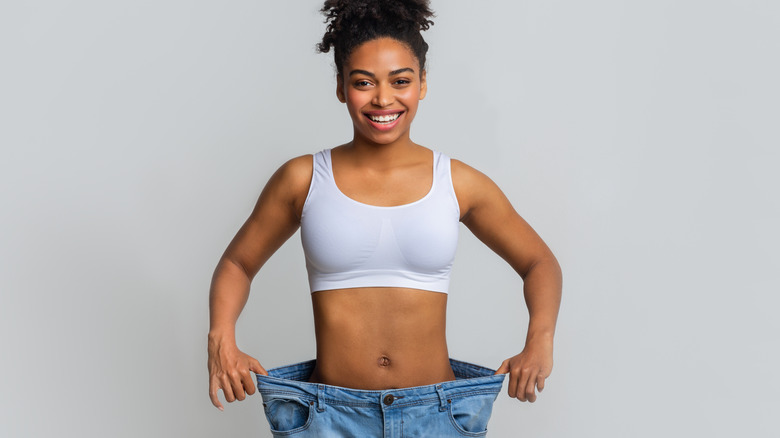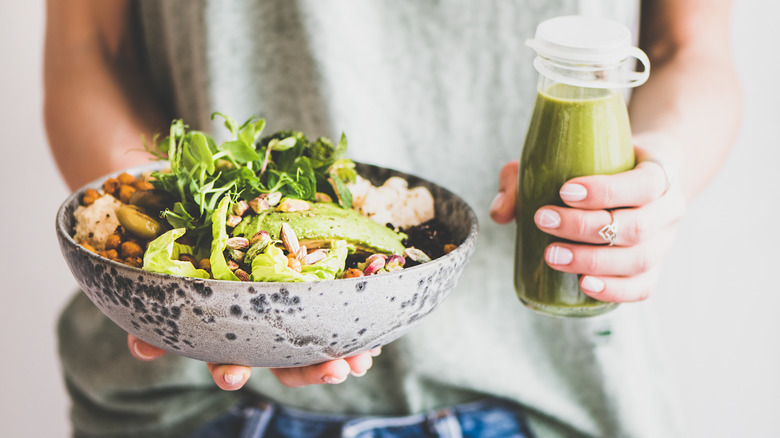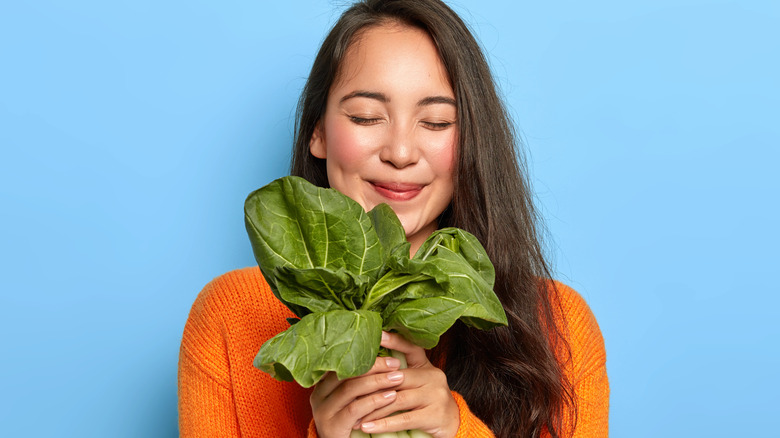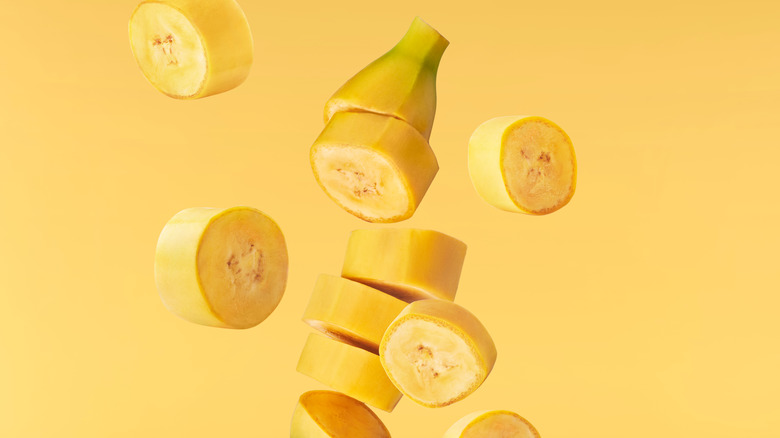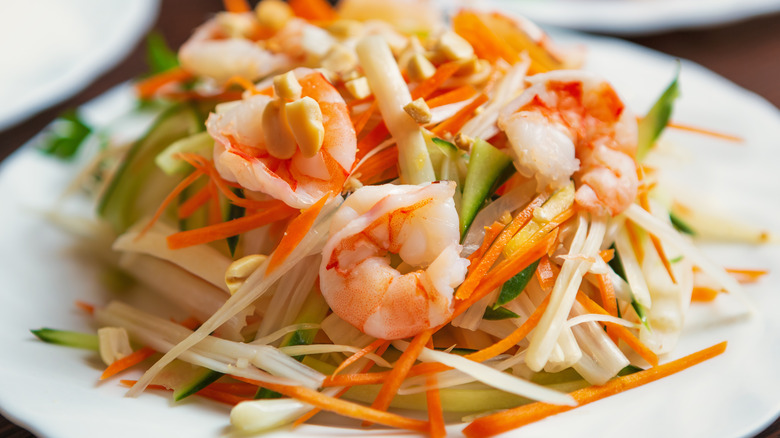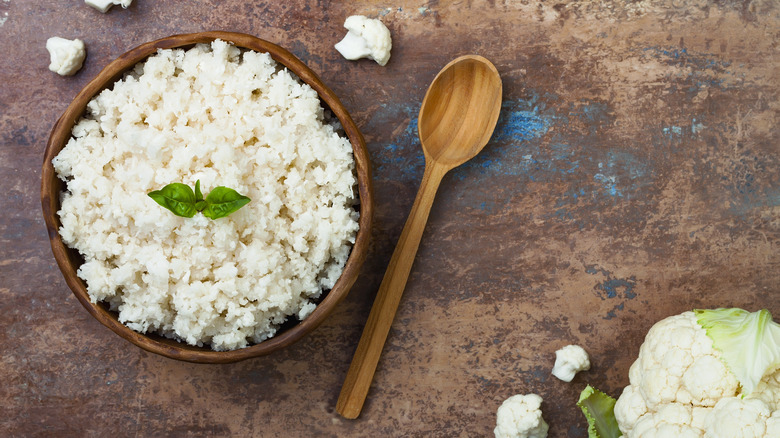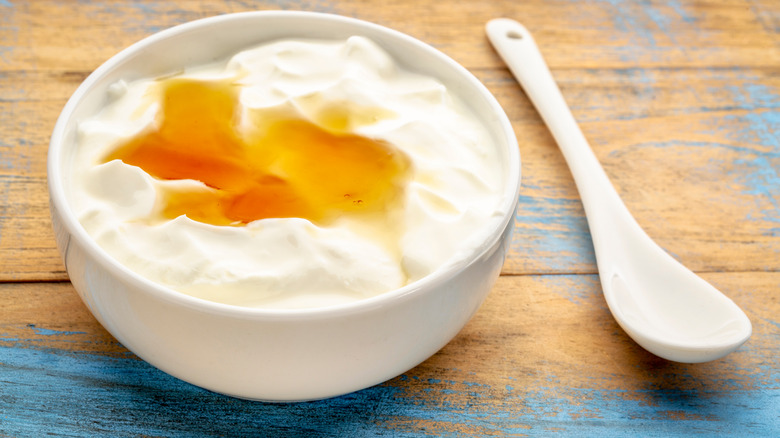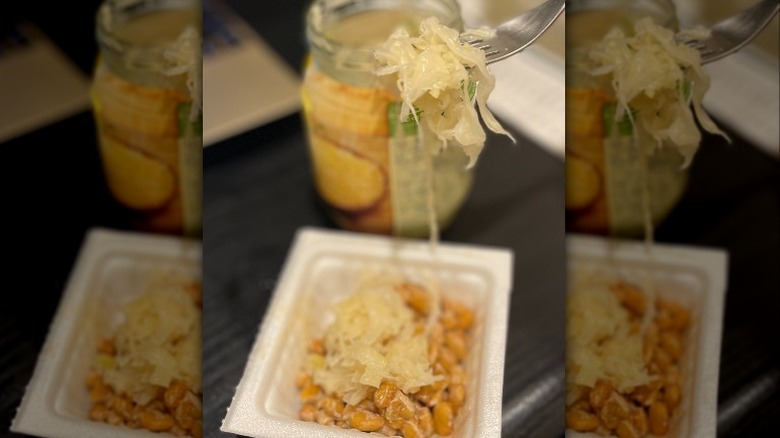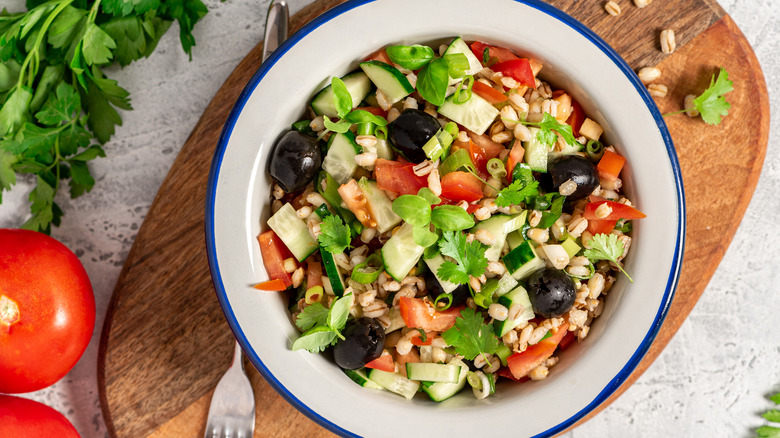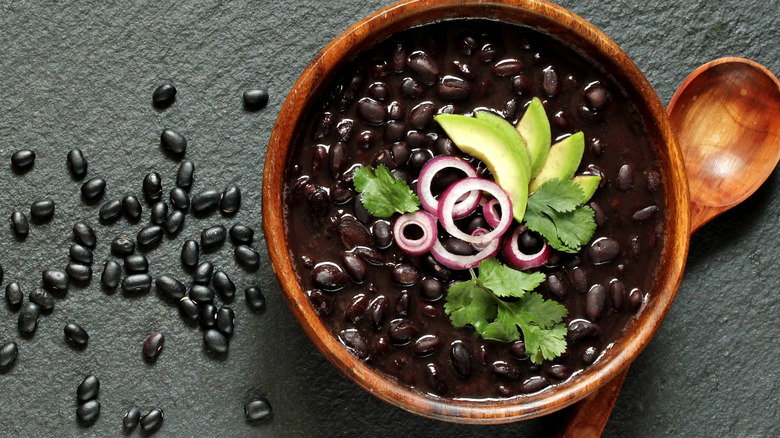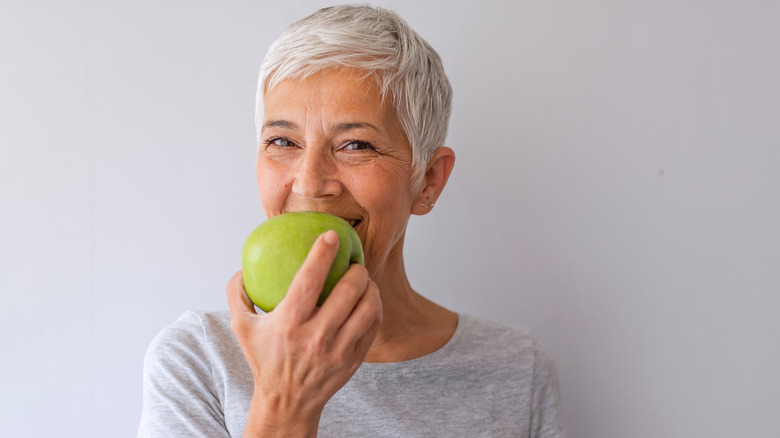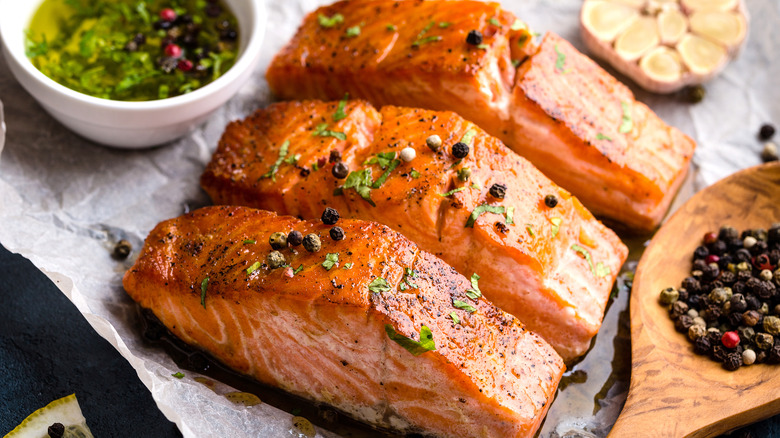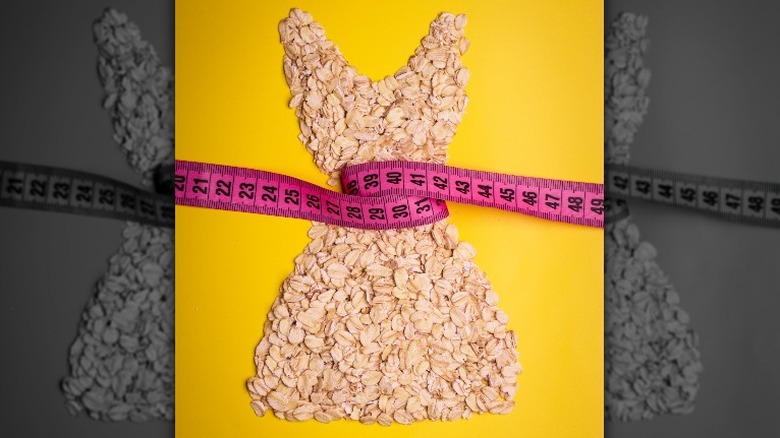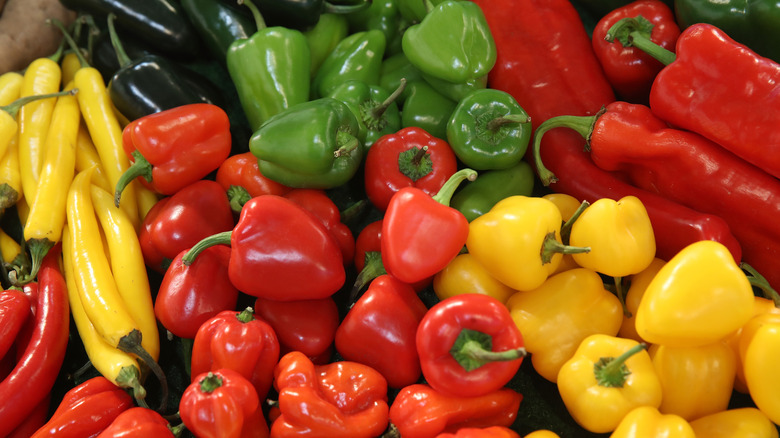The Best Foods To Eat If You Struggle With Belly Fat
If you have excess fat hanging around your belly area, you know how stubborn it can be, and how hard it is to get rid of. Even if you watch calories and stay relatively active, getting rid of belly fat can make you feel like your efforts are in vain. However, science shows that getting rid of fat that sits in your abdominal area relies heavily on the types of food you eat every day.
For instance, NASM explains the importance of adding enough protein to your diet when you're trying to slim down your gut. Protein assists metabolism — the process that breaks down your food — helps you feel fuller longer after eating, and creates lean muscle mass that can burn fat, even when you're resting. And, unlike carbs, your body doesn't store protein as fat quite so easily.
Fiber is another necessary component of a belly fat-busting diet. A 2015 study published in the Annals of Internal Medicine found that adding more fiber to your diet each day could improve your weight loss results. Dr. Frank Hu, a professor at Harvard Medical School, tells Harvard Health Publishing, "In addition to weight control, higher fiber diets can also help to prevent type 2 diabetes and cardiovascular disease." Extra fat around the belly is known to be a precursor to insulin resistance and type 2 diabetes.
What foods have the protein, fiber, and other nutrition your body needs to finally say goodbye to belly fat? Read on to find out how to stock your fridge and pantry.
Avocado has fat your belly needs
Do you usually add a heaping tablespoon of mayonnaise to your sandwiches, or douse your salad in sugary dressing? These habits can certainly lead to an accumulation of belly fat that's difficult to get rid of. Avocado, however, could be an excellent alternative.
Although avocado is high in fat, it's high in good-for-you fat (per Cedars-Sinai). More specifically, the fruit contains monounsaturated and polyunsaturated fats, which are known to lower cholesterol. They also are high in fiber, plus they're packed with nutrients your body needs every day, like potassium and vitamin C. Another bonus: Due to their fat and fiber content, avocados could increase feelings of fullness after eating. One 2013 study published in Nutrition Journal found that when participants added ½ an avocado to their lunch, their meal satisfaction increased and their desire to eat in the hours after lunch decreased.
Even more intriguing is the possibility that avocados could actually change where fat ends up, at least in women. According to research from the University of Illinois at Urbana-Champaign (via Science Daily), women who ate one avocado each day during the research period had reduced visceral abdominal fat, and reduced their ratio of visceral to subcutaneous fat (via The Journal of Nutrition). As Harvard Health Publishing explains, visceral fat surrounds organs while subcutaneous fat lies under the skin and around the abdomen's wall — and because visceral fat is associated with the production of molecules that are harmful to the body, it's better to have less of that kind.
Leafy greens can replace high-calorie foods
You probably have heard that leafy greens are go-to foods to add to a healthy diet. But aside from offering you plenty of daily nutrients like calcium and Vitamin C, they also have properties that could lead to weight loss and a decreased diabetes risk. According to Eating Well, the high fiber and water content of leafy greens help your belly feel full long after eating, so you'll be less likely to binge later. And, antioxidants in these greens could contribute to a diabetes-friendly diet.
If some greens aren't your thing, try others — there are plenty to choose from. Kale, cabbage, lettuce, bok choy, and beet greens are just a few possibilities, and they all have unique flavors (via Healthline). Which one is best for your belly fat? Dietician Jenny Champion tells Eat This, Not That! that spinach is her top pick. First off, it's super low in calories, so you can easily fill up your plate without worrying about going over your limit. Plus, "spinach is a great way to keep up your veggie intake while you're on a low-carb diet," Champion explains, noting that carbs are infamous for making weight loss a challenge.
Bananas offer low-fat nutrition
Bananas get somewhat of a bad reputation in the fat-loss department, mostly because of their carb content. The USDA states that a medium ripe or slightly ripe banana has 23 carbs and 15.8 grams of sugar. However, just because bananas might have more carbs than, say, a slice of watermelon, doesn't mean they're bad for you or will add fat to your midsection.
In fact, Verywell Fit says that bananas can be a completely healthy part of a balanced diet, especially if you're careful not to go overboard on your consumption of them. For starters, they're low in fat. Plus, bananas are naturally very filling, so adding them to your oatmeal, yogurt, or smoothie can make you feel fuller until your next meal. But bananas can be relatively high-calorie snacks, so be careful about portioning to get all the health benefits — like lots of vitamin C and potassium — without the excess calories.
Want to make sure your bananas are contributing to a slimmer belly? Reach for the green ones (via Healthline). Greener bananas have what's known as resistant starch, which your small intestine doesn't break down, therefore giving you all the benefits of dietary fiber. Because green bananas are more fiber-rich than yellow, ripened bananas, they could improve those feelings of satisfaction after eating.
Shrimp is high in protein and healthy fats
Getting enough protein in your diet — protein should account for 10-35% of your daily calories, according to Mayo Clinic — is crucial to keeping abdominal fat in check. A 2021 study published in The Journals of Gerontology found that older men who increased their daily protein intake had better visceral fat reduction results than those with a more moderate protein intake.
Adding shrimp to your meals could be one of the simplest and best ways to get more protein in your diet. WebMD states that these crustaceans are low in calories, but in just three ounces have a whopping 12 grams of protein. They're also low in saturated fats, but are decent sources of good fats.
Of course, the way you cook shrimp can make a difference in their health benefits. For instance, frying it in oil adds unnecessary calories, oil, and fat to your meal. But cooking up a healthy shrimp pasta recipe loaded with vegetables and lightly seasoned shrimp can give you all the health benefits without adding fat to your middle.
Cauliflower is a versatile alternative to carb-filled foods
Cauliflower seems to be one of the most popular low-carb trends, but this is one trend you might want to hop on board with. Not only is cauliflower super healthy for you, but it can also be an excellent alternative for high-carb stuff you love to eat, like bagels and pasta, that might not lend themselves to the slimmer waistline that you want.
According to Healthline, cauliflower is an excellent source of potassium, vitamin C, vitamin K, and folate. It's also low in calories, high in fiber, and contains lots of water, which can assist your weight loss goals. You'll only get about five grams of carbs in one full cup of cauliflower, too.
It's also incredibly versatile, with the ability to transform into pizza crust, rice, and just about anything else that usually has a high number of carbs. For instance, creative chefs have turned cauliflower into seasoned rolls, tater tots, bagels, nacho chips, and fried rice (per Tasty).
Greek yogurt brings healthy bacteria into your gut
One reason you might be hanging onto fat around your belly is that your gut isn't balanced with the right bacteria. Gut health relies on good bacteria to balance out the bad bacteria (via WebMD). When there's an imbalance, you could wind up with harder-to-control weight gain. Probiotics can get your gut to a healthier state, control your appetite, and regulate how your body stores fat (via Healthline).
An excellent source of probiotics is yogurt. However, not all yorgurts are created equal. Registered dietician nutritionist Maggie Michalczyk tells Women's Health that choosing yogurt marked with "live and active cultures" ensures that you're getting the probiotics you want. Another thing to look for is high protein content and low-sugar or no-sugar varieties. One type of yogurt that can check several boxes for a healthy tummy is Greek yogurt. "What makes Greek yogurt different from regular yogurt is that it's thicker and creamier due to the extensive straining process," Michalczyk explains. "This is also what makes Greek yogurt richer in protein."
Sauerkraut could change how your body absorbs fat
Sauerkraut is certainly one of those foods that may not appeal to the masses. Its strong smell and unique taste is one that people seem to love or hate. But there's no denying that this fermented food belongs in a healthy diet. According to the USDA's nutrition data, one cup of sauerkraut has fewer than six carbs, a good amount of potassium and vitamin C, and only about 55 calories. Plus, it's low in saturated fat and has lots of water content.
More important news for your belly is that sauerkraut is an excellent source of probiotics (per WebMD). A scientific review published in a 2019 edition of Nutrition explored the relationship between probiotics, fat absorption, and obesity. Researchers found significant evidence in studies to suggest that having the right bacteria in the gut can help regulate lipogenesis — the process by which the body produces and stores fat – and that probiotics help maintain that healthy balance of bacteria. Furthermore, Healthline states that sauerkraut is fermented with lactic acid bacteria, and the review's researchers found that this kind of bacteria, specifically, decreased abdominal fat and obesity in clinical trial participants.
Air-popped popcorn is a go-to healthy snack
Popcorn is proof that you don't need to give up all snacks if you're trying to slim down your stomach. For starters, a serving of popcorn contains about 3 grams of protein, so it can help boost your numbers if you're looking for easy ways to add more protein into your diet (per Medical News Today). It's also a good source of magnesium, potassium, and calcium. A serving also has a good amount of fiber to promote healthy digestion. But perhaps the top reason to keep it as a go-to snack is that it's a whole grain.
The Harvard T.H. Chan School of Public Health explains that whole grains include all the parts of the grain (as opposed to refined grains, in which some parts are removed), allowing them to hang onto all their natural fiber, vitamins, and nutrients. Researcher and scientific advisor to the Whole Grains Council Nicola McKeown tells Tufts Now that cutting out grains completely could lead to weight loss, but it's a short-term strategy. Instead, switch to whole grains, which according to research led by McKeown can decrease belly fat by as much as 10%.
However, Medical News Today warns that how you prepare your popcorn is important. Avoid dousing it with butter, salt, sugar, and anything else that might raise its calorie and fat composition.
Barley could regulate your appetite
Barley is a grain packed with nutrition, from its high antioxidant content to its nutrient profile of magnesium, selenium, fiber, and other vitamins and minerals your body needs (per Healthline). Because it's so rich in fiber, barley can keep you feeling full long after a meal. And, because its fiber is soluble fiber, your digestion could get on track when you eat it, as it helps feed the good bacteria in your gut.
A 2015 study published in The British Journal of Nutrition found that an increase in dietary barley could boost metabolism, insulin sensitivity, and appetite regulation. Out of the study's 20 participants, some were fed white bread while others were fed kernel-based barley bread for three days. Those on the barley bread diet had an increase in gut hormones that are responsible for sensitivity to insulin, glucose control, and appetite regulation. According to the study's researchers, these hormones also play a role in inflammation. Inflammation in the gut has ties to obesity, excess belly fat, insulin resistance, and type 2 diabetes (via Columbia University Irving Medical Center).
Beans keep your gut bacteria on track
Do you want a food that adds lots of fiber to your diet and is high in protein, low in fat, and vegan-friendly? Try beans. According to Parade, bean varieties like black and lima beans have a good amount of soluble fiber, which can improve gut health and slow digestion. Medical News Today also lists a variety of bean benefits, including feelings of fullness after eating, reducing the risk of fatty liver disease, and increasing the bacteria that helps your gut metabolize food.
Researchers from Wake Forest Baptist Medical Center also found a link between the soluble fiber that beans provide and decreased fat accumulation. When participants increased their soluble fiber intake by 10 grams per day, the result was a 3.7% decrease in the visceral fat that surrounds the organs over a five-year period. Although the researchers admitted that more work needed to be done to figure out the exact relationship between fiber and fat loss, lead researcher Kristen Hairston says, "Our study is valuable because it provides specific information on how dietary fiber, especially soluble fiber, may affect weight accumulation through abdominal fat deposits."
Apples take time to digest
Apples are high-fiber fruits, and contain both insoluble and soluble fiber (via Healthline). Soluble fiber plays an important role in digestion because it slows the process down. That might sound like a problem, but it's necessary for our bodies. Here's why: Self explains that when our digestion slows, it also helps our bodies regulate the absorption of stuff that we might not need, like excess carbs or fat. And be sure to eat the whole apple, because the skin contains insoluble fiber, which is equally important for gut health — this kind of fiber moves things along in the digestive tract, and keeps you feeling full after eating.
Apples could help your gut in other ways, too. Research has found that polyphenols in apples could have the power to reduce body fat and increase muscle strength (via Muscle & Fitness). Registered dietician nutritionist Elizabeth Gunner tells Eat This, Not That! that apples are a good choice for a low-calorie snack too. Gunner suggests adding a little peanut or almond butter to your apple for an extra health boost and a feeling of fullness after eating one.
Salmon's oils could contribute to a healthier waistline
Registered dietitian Cynthia Sass tells Today that the key to burning fat is actually to add fat to your diet: "When you cut fat too low, your carbohydrate intake generally increases, which can result in a surplus of unburned carbs that wind up feeding fat cells," she explains. Of course, the fats that you add to your plate should be good-for-you fats, like monounsaturated and polyunsaturated fats.
One food that does the job is salmon. Farmed salmon contains about 12 grams of fat, while wild salmon includes about 8 grams. A good amount of its fat content comes in the form of omega-3 fatty acids, which we can only get through our diets (via Healthline). These omega-3s appear to play a role in fat loss — one study published in the Journal of the International Society of Sports Nutrition found that participants who took fish oil supplements containing omega-3s for six weeks had, on average, a significant decrease in fat mass, a significant increase in fat-free body mass, and some subjects had a lower body fat percentage. Healthline explains that just two servings of salmon each week could give you the omega-3s your body needs.
Oats can reduce weight and waist size
If you're specifically targeting the fat around your belly, adding more oatmeal to your daily routine could be a good place to start. Gastroenterologist Chaim Ross tells Insider, "Oats help people feel full, decrease sugar spikes, and decrease insulin. Those are the properties that make you feel full, so you stop eating." It's also high in fiber and low on the glycemic index, in case you still need a bit of convincing that oatmeal should become a breakfast staple.
Another perk? According to research published in a 2013 edition of Plant Foods for Human Nutrition, a diet that includes oats can reduce waist-to-hip ratio. The study also found that the group eating oats had decreased body weight, body fat, and body mass compared to the control group.
If oatmeal sounds a bit bland, try adding in some other yummy and healthy items to improve the flavor. Woman's World suggests topping oatmeal with a flavored protein powder to boost its protein content. Or, try good-for-you toppings like coconut or berries to add to the taste.
Several pepper varieties could be the keys to weight loss
The next time you're at the store, grab some peppers to put in your cart. It doesn't necessarily matter which kind, either, because science shows that many of them can lead to a slimmer waistline.
If spicy peppers are your go-to, you're in luck. Spicy peppers contain a compound known as capsaicin, which has fat-burning properties (via Metabolic Research Center). A 2017 review in Bioscience Reports states that capsaicin can potentially aid metabolic and digestive health by increasing intestinal blood flow, improving energy expenditure, and decreasing adipogenensis, the process of fat accumulation. But don't worry if you can't handle the heat of hot peppers. Sweeter bell peppers also have similar effects, although on a potentially smaller scale. They contain a compound similar to capsaicin known as dihydrocapsiate, which researchers in a 2018 study found may improve glucose intolerance and decrease fat accumulation (via Nutrition Research). This study was performed on mice, though, so more research is needed to confirm similar findings in humans.
Maybe black pepper is more up your alley? It also contains a component that could slim your waistline. It's called piperine, and a 2012 study in the Journal of Agricultural and Food Chemistry found that it could interfere with the transformation of regular cells into fat cells.

